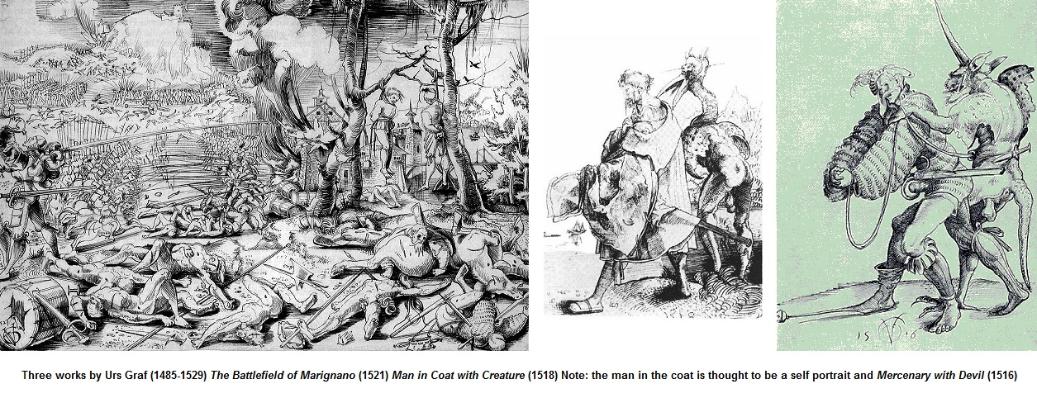THE BADDEST OF RENAISSANCE BAD BOYS - THE LIFE & ART OF URS GRAF
In the 1949 classic film ‘The Third Man’, the villain Harry Lime (played by Orson Welles) remarks that the Swiss enjoyed 500 years of peace and brotherly love and produced nothing but the cuckoo clock. This line, from a screenplay written by Graham Greene, is intended to provoke a debate on whether war inspires great art but it also does the Swiss a great disservice.
Switzerland’s famous neutrality only dates from the 1815 Treaty of Paris moreover, during the Medieval and Renaissances periods, the Swiss cantons produced some of the the best soldiers in Christendom as well as an extraordinary artist named Urs Graf.
Graf was a contemporary of Leonardo de Vinci, Michelangelo and Albrecht Durer but if his work is little known today it’s perhaps because his woodcuts and engravings illustrate the darker side of Renaissance life. Instead of portraits of fine ladies or edifying stories from the bible, Graf’s art features horrific scenes and grotesque characters drawn from his own experiences. Although he was married to Basel blue-blood Sibylla von Brunn (whose parents disinherited the poor girl) Graf spent much of his life in the underworld inhabited by thieves, harlots and soldiers-of-fortune and this led to his frequent imprisonment.
Graf was born in 1485, in the Swiss city of Solothurn and he spent his early years training to be a goldsmith like his father. As a young man he travelled to Strasbourg to learn the art of making woodcuts and by 1509 he’d earned enough money to buy a citizenship in Basel. He worked as an illustrator for the publishers Adam Petri, Jean Froben and Johannes Amerbach, and he also studied the art of glass painting. However, whilst his professional career prospered his personal life soon fell apart and he was arrested on numerous occasions for ‘wife beating' and ‘consorting with harlots’.
It was about this time that Graf began his parallel career as a mercenary soldier. He’s known to have fought in Italy in 1510, Dijon in 1513 and Milan in 1521. He’s also thought to have been at the Battle of Marignano [1515] which was one of the bloodiest engagements in the long series of wars fought by the French, the Holy Roman Empire, the Venetians and the Papacy for control of Northern Italy. Marignano pitted the Swiss against a Franco-Venetian army and it began with Graf’s comrades-in-arms making a suicidal charge at the French artillery.
In spite of their courage, the Swiss were defeated and the slaughter inspired one of Graf’s most chilling works. ‘The Battlefield of Marignano’ depicts the full misery of war: the foreground is a jumble of mangled limbs and severed heads whilst the trees behind are festooned with the corpses of men hanged for desertion. Only someone who’d witnessed these atrocities first hand could have recorded them in such detail and graphic violence often features in Graf’s work. Woodcuts such as ‘The Execution Ground’ and ‘Two Prostitutes Beating a Monk’ hint at a man whose soul is deeply troubled.
Between campaigns Graf returned to Basel but, like so many soldiers through the ages, he found it hard to adjust to civilian life and in 1518 he was forced into exile after being charged with attempted murder. The reason why he beat a man half to death have been lost in the mists of time but, as his victim survived, Graf was allowed to return to Basel a year later. In 1520 Graf used some of the loot he’d brought back from the Italian Wars to buy a house in Basel called Zur Guldin Rosen (the Golden Rose) and which is now the rather less romantically named 18 Stadthausgasse.
Despite re-enlisting for the Milan campaign of 1521, and his repeated appearances before Basel’s exasperated magistrates, Graf was employed by the city’s mint and held prominent positions in the city’s guild of goldsmiths including Kieser (elector) and Stubenmeister (manager). In 1523 his fellow guild members successfully petitioned for Graf to be released from yet another period of incarceration to take part in a shooting contest!
Sadly his friends’ loyalty failed to help Graf find peace and after 1527 his name disappears from Basel’s city records. Some sources maintain that this indicates he died in this year, and certainly the long-suffering Sibylla remarried in 1528, but there is a drawing bearing his distinctive cipher (Graf was one of the first western artists to sign and date his work) dated 1529 so it’s highly possible that he simply abandoned his wife and son and resumed his life as a mercenary.
Graf may have died on the battlefield, in prison or during a tavern brawl, but whatever his fate he left behind an important body of work that’s a vital resource for historians researching life in the 16th Century. Though his art may lack the delicate beauty of Botticelli or the dramatic grace of da Vinci, his drawings are full of the raw vitality of a man who lived his whole life in the shadow of death.
Graf’s life as a mercenary inspired several episodes in my book The Devil’s Band and to see more of his work please take a look at my website http://www.thedevilstonechronicles.com/Urs-Graf.php
Finally here’s that Harry Lime quote in full:
“Don't be so gloomy. After all it's not that awful. Like the fella says, in Italy for 30 years under the Borgias they had warfare, terror, murder, and bloodshed, but they produced Michelangelo, Leonardo da Vinci, and the Renaissance. In Switzerland they had brotherly love - they had 500 years of democracy and peace, and what did that produce? The cuckoo clock. So long Holly.”
Urs Graf is one of the historical figures that inspired Thomas Devilstone - the hero of The Devil's Band. To order click here
